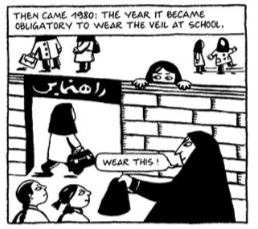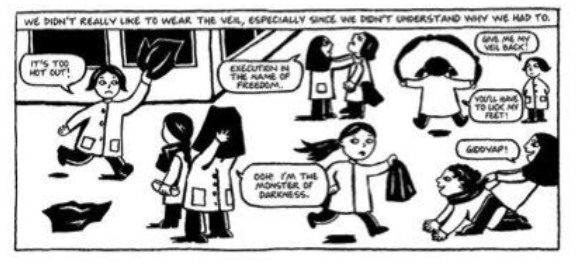a Guide to Graphic novels
The structure of graphic novels


| Term |
Definition |
| Panel |
A framed image or a single drawing. A panel can also be borderless. |
| Gutter |
A space between the panels. It allows the reader to fill in the blanks and imagine what happens between the panels. |
| Voice over |
A hard line on top or bottom of the panel with a writer's note. This way narrators have a possibility to speak directly to the readers. |
| Speech bubble |
Represent speech or thoughts of a given character. You should pay attention to their shape. If they appear as clouds, the character is thinking, if they are made out of abrupt and sharp lines, the character is shouting. |
| Emanata |
Anything that shows emotion: teardrops, exclamation or question marks, motion lines, etc...
Refer to the panel no. 2.
|
| Icon |
Representative of an idea or a group of people.
Refer to the panel no. 3. God can be referred to as an icon.
|
| Splash |
A panel that makes up the whole width of a page. If it takes up the whole page it is called a "bleed" |
Transitions
- Moment to moment - time difference between panels is very small.

- Action to action - from one basic movement to another. An object progressing through a single action.

- Subject to subject - change of perspective in the same event.

- Scene to scene - a jump between large amounts of time and/or space.

- Aspect to aspect - shows different things occurring at the same time in the same scene.

- Non-sequitur - not connected in any way.
 The layout
The layout
- Foreground - visual plane that appears closest to the viewer.
- Midground - visual plane that sets in the middle or off-center. It allows for a subtle transition from the foreground to the background.
- Background - objects at the back of the panel that add context.

This panel has a background, a midground, and a foreground. The focus is concentrated on the supposed teacher and two girls, so they are the foreground. Children in the back add context - it is set in a school, so they are depicted in the background. A girl going through the entrance and the fence itself are in the midground, as they serve as a sort of transition from the front to the back, making the change between the two more subtle.
Some important concepts in graphic novels
- Graphic weight - a term that describes the way some images draw the eye more than others, creating a definite focus using color and shading in various ways and some contrast in the image.
- Time - graphic novels don't have to tell the story in chronological order. This concept can even be used to show multiple things happening at different times within the same panel.

- Camera angle - imagine that the panel is a photograph. Now, the things to consider are: the position of the camera in relation to its subject, the distance between the camera and the subject, the angle, and how it all affects our perception of the picture.
Editors- polina.blinova - 514 words.
View count: 4012